Friday, October 13, 2006
Ephesus, The Basilica of St. John, and the Ephesus Historical Museum
We left the hotel at 7:30 in hope that we might beat the cruise ship tours. Success! Arriving at least 20 minutes before the crowds, we were all eager to see the city that Paul lived in for a few months (Acts 18:19-21) and then on his second visit for about three years. Our guide talked about the history of the city on the bus ride over. Reggie asked some great questions and then shared a bit of the wealth of his knowledge, connecting the dots for us as we thought through what we’ve read in the New Testament about the Church at Ephesus and then tried to bring those thoughts into alignment with what we were seeing.
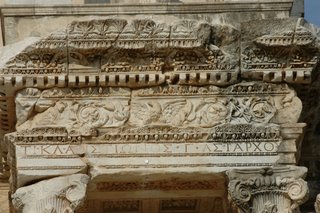
Ephesus is an old city, even by ancient standards, dating back to 2000 BC. Its harbor surrounded by hills was an ideal port for the ancient shipping trade, and was much prized by conquering invaders. Captured by the Lydians in 560 BC, the Persians in 546 BC, and Alexander the Great in 334 BC, it was the prize of all who traveled its way. The Temple of Artemis, built under the Greek rule, was considered one of the Seven Wonders of the Ancient World. The Goths sacked the city in A.D. 262 and the temple was destroyed.
Ephesus was subsequently under the rule of the Roman Empire until 330 AD, when the Byzantines took control of Asia Minor. The city was the seat of a church council The General Council of Ephesus, in 431, and was abandoned in the tenth century when the harbor became filled with silt. Below is a site map for the city.

Walking down the main street of Ephesus, we saw ruins of merchant’s shops and public buildings. We paused every few moments to take pictures under arches and to look at the Greek and Roman inscriptions found at the front of some of the buildings. The craftsmanship in the architecture was incredible, and one could easily imagine the beautiful marvel that this city had once been.
One building necessary for any city is the public latrine.

The library at Ephesus was magnificent! The front of the building still stands as a testament to its architect.


We posed for a group photo on the library steps and took a moment to buy some Magnum Ice cream bars from a vendor. Marla's face was covered in chocolate in a matter of minutes.

Statuary has mostly been removed to museums, but marble carvings like this one of Hermes line the main street.

Excavations have been underway on family dwellings that were uncovered on the hillside near the Library.

It has now been determined that the homes uncovered must have belonged to a Priest, as the floors were made of intricately inlaid marble and mosaics, and the walls adorned with frescos, mosaics, and carvings. Archeologists have been reconstructing the living areas and it looks like it must have been quite luxurious.

Joe and Rita
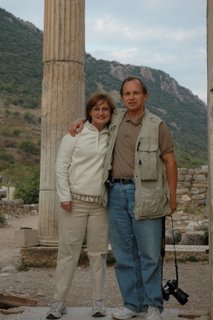
We spent some time in the amphitheater, listening to Reggie read to us from Acts 19:11-41, the account of the silversmiths at Ephesus inciting the crowds to riot against the Christians in their midst.

We then sang a hymn together while we took it all in. The experience was slightly surreal… I could close my eyes and see the crowds. Each of us found it to be one that we would not soon forget.
Here's a shot of Sam and Mary Beth just outside the amphitheatre.

These Christian symbols were carved into the paving stones in front of the amphitheater.
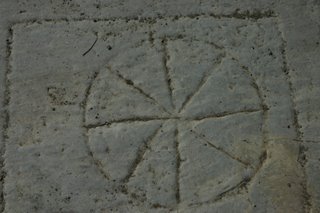
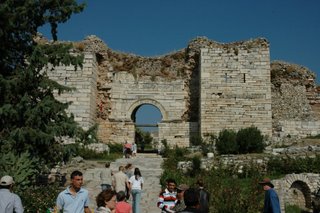 Near Ephesus is the Basilica of St. John where the apostle John was believed to have lived the last years of his life and where he was buried. A church was constructed 300 years after his death over the site of is tomb. A basilica was later built under the reign of Justinian, somewhere between 527-565 A.D. The basilica was in the shape of a cross and had 6 domes. Most of the building was destroyed in an earthquake in the 14th century.
Near Ephesus is the Basilica of St. John where the apostle John was believed to have lived the last years of his life and where he was buried. A church was constructed 300 years after his death over the site of is tomb. A basilica was later built under the reign of Justinian, somewhere between 527-565 A.D. The basilica was in the shape of a cross and had 6 domes. Most of the building was destroyed in an earthquake in the 14th century.  One item that was left unmarred was the beautiful cruciform baptismal font in the center of the church floor.
One item that was left unmarred was the beautiful cruciform baptismal font in the center of the church floor.  After an outdoor lunch at a restaurant next to a local farmer’s market, we traveled to the Ephesus Museum where many of the priceless artifacts from Ephesus are on display.
After an outdoor lunch at a restaurant next to a local farmer’s market, we traveled to the Ephesus Museum where many of the priceless artifacts from Ephesus are on display. 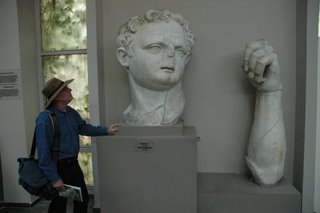 Reggie with Diometian, the Roman Emperor who proclaimed himself a god, and also is said to have exiled the apostle John to the Island of Patmos. This statue in its entirity stood in the Temple of Diometian in Ephesus.
Reggie with Diometian, the Roman Emperor who proclaimed himself a god, and also is said to have exiled the apostle John to the Island of Patmos. This statue in its entirity stood in the Temple of Diometian in Ephesus. The bust of Marcus Aurelius.

Driving back to our hotel, we chatted companionably and talked over the many things we’d seen. We’d walked on some of the same streets as Paul in the past few days and had seen places we’d only been able to imagine prior to this trip. After 9 days of travel, we were all exhausted and exhilarated at the same time. What an amazing journey.
 Tomorrow morning we would leave for Istanbul for one last night in this beautiful country. Slipping into sleep, I drifted down a street lined with marble columns, Christian symbols etched into the paving stones, and chocolate smiles from Ephesus.
Tomorrow morning we would leave for Istanbul for one last night in this beautiful country. Slipping into sleep, I drifted down a street lined with marble columns, Christian symbols etched into the paving stones, and chocolate smiles from Ephesus.
No comments:
Post a Comment